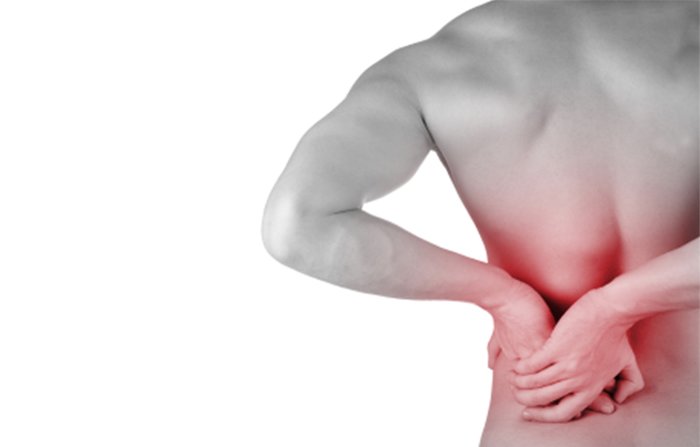It's a weird contradiction: What do you want to do when you're tired? You just want to sit down and relax. But when you sit down for hours at a time, your body—especially your lower back—can pay a heavy price.
How can sitting be both good and bad for you?
It's a matter of how long you sit, of course. When you sit for hours on end, your muscles grow accustomed to being "folded up." As you sit there nearly motionless, staring at the screen, your hips are completely flexed, which causes your hip flexors to shorten and your glutes to weaken. Your shoulders roll forward, your core deactivates, and your posterior chain effectively goes to sleep.
It may seem like nothing much is going on. I mean, how can you hurt yourself just sitting in a chair? But all that shortening, tightening, and weakening of your core and hip muscles leads to imbalances and instabilities that result in lower-back injury and pain for millions of people.
Simple alternative to surgery and drugs
Back pain is real, serious, sometimes debilitating, and extremely common. According to The American Chiropractic Association, an estimated 80 percent of the population will experience back pain at some point in their life. Worldwide, back pain is the leading cause of disability.[1]
Most back pain can be managed with non-surgical treatments. Many back-pain sufferers turn to medication, with highly addictive opioids being one of the most commonly prescribed drugs. But according to a 2015 meta-analysis published in the journal Clinical Rehabilitation, strength and stability training provide a safe, non-addictive alternative to surgery and drugs.[2]
Before you run off to the gym and crank out hundreds of low-back extensions to fortify your back and core muscles, slow your roll.
"A lot of people focus in on the low back and find exercises to target that area directly, when they may need to consider other areas that are contributing to their back pain," says Tyler Spraul, a certified strength and conditioning specialist and the head trainer at Exercise.com. "It's helpful to start from the ground up and evaluate all the moving parts between your back and the ground that are engaged when you walk, run, or do other exercises. The problem might not be just in your back."
Strengthen your core muscles—all of them!
A 2016 study published in the European Spine Journal focused on gluteus medius muscles, the glute muscles that wrap around your hips and are responsible for hip abduction. People with weak medius muscles were more likely to experience chronic, non-specific lower-back pain than those without weakness.[3]

What many people don't realize is that the hips and shoulder girdle are part of the core along with the abdomen and back muscles. These muscles are included because they contribute significantly to stabilization and to the transference of energy between the lower and upper body. By approaching core training with a broader scope than knocking out a few sets of sit-ups, you'll have a better chance of using your workout to combat lower-back pain.
Spraul suggests using the following four exercises in your back-pain relief program. You'll hit all of the major muscle groups of your hips and core, with an extra focus on the deep transverse abdominis, the erector spinae, and of course, the gluteus medius.
1. Plank reach and plank with leg lift
Start in a standard plank position, with your elbows under your shoulders, legs extended, and your core tight with your bellybutton pulled back toward your spine. Tuck your pelvis under slightly to prevent your hips from creeping upward.
Once you're in the plank position, raise one foot off the ground, holding it up without allowing your hips to shift or twist. Lower it back to the ground, then perform the same with the opposite leg.
Lower your leg back down, then lift one arm off the ground, again, keeping your body parallel to the floor and preventing your hips or shoulders from shifting or twisting. Hold your arm up briefly, lower it down, then repeat with the opposite arm.
Continue the sequence until you've lifted and lowered all of your limbs five times, or until you can no longer maintain proper form.
2. Single-leg hip thrust
Sit on the floor next to a bench with your knees bent at 90 degrees and your feet flat on the ground. Engage your core and lean back, positioning the bench close to the bottom of your shoulder blades. Pull one knee toward your chest, lifting your foot from the ground.
With the foot that's planted, press forcefully through your heel, using your glutes to press your hips up until fully extended. Hold for a second, then slowly lower your hips back to the floor. Perform 10-12 repetitions on one side before switching. Complete 2-4 sets.
3. Pallof press
The Pallof press works on anti-rotational core strength by targeting your deep abdominals while simultaneously working your chest and shoulders.
Using a cable machine or a resistance band, stand perpendicular to the anchor point of the cable or band, and take a couple steps away to add space between yourself and the anchor.
Hold the handle or band with both hands, engage your core, bend your knees slightly, roll your shoulders back so you have perfect posture, and, as you inhale, position both hands at your sternum. Hold this position for 5 seconds.
As you exhale, keep your torso perfectly stable and press both hands straight out in front of you at chest height. Hold for 5 seconds. Inhale, and bring your hands back to your sternum and repeat the movement. Perform 2-4 sets of 10-12 repetitions.
4. Clam shell
To get at the tricky gluteus medius, you can't go wrong with the clam shell. It is best done with a small resistance band, but if you don't have access to a band, just to the exercise without it.
Place the resistance band just above or below your knees. Lie on your side with your feet stacked. Bring your legs forward and bend your knees so your hips are aligned with your ankles. Support your neck with your arm, and place your top hand flat on the ground in front of your chest for support.
Keeping your feet touching, abduct your top hip by opening it up away from your bottom leg, pulling against the resistance of the band. Slowly lower your top leg back to the starting position. Perform 3 sets of 15-20 repetitions per side.
References
- American Chiropractic Association. (1994). Back pain facts & statistics.
- Searle, A., Spink, M., Ho, A., & Chuter, V. (2015). Exercise interventions for the treatment of chronic low back pain: a systematic review and meta-analysis of randomised controlled trials. Clinical Rehabilitation,29(12), 1155-1167.
- Cooper, N. A., Scavo, K. M., Strickland, K. J., Tipayamongkol, N., Nicholson, J. D., Bewyer, D. C., & Sluka, K. A. (2015). Prevalence of gluteus medius weakness in people with chronic low back pain compared to healthy controls. European Spine Journal,25(4), 1258-1265.

